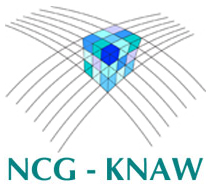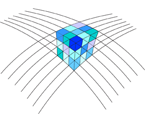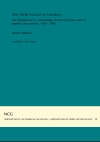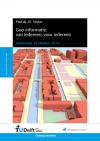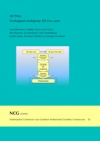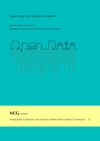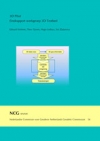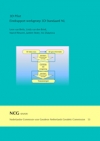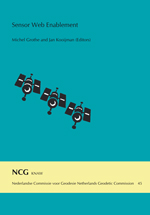


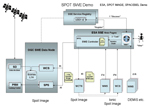

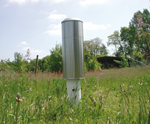
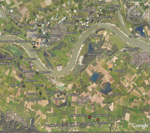
Michel Grothe and Jan Kooijmans (Editors)
Nederlandse Commissie voor Geodesie 45, Delft, 2008. 87 pagina's.
ISBN: 978 90 6132 305 1.
Editorial
In the geo-information community in the Netherlands the concept of Spatial Data Infrastructures has gained increasing attention. In the last two years this has led to several implementations especially in geoportals, operational web mapping services for governmental data, updated data policies and renewed governance and institutional support. Today the Geo Data Infrastructure in the Netherlands is under development with a strong focus on realization of web (services) accessibility of geo-information through geoportals and web mapping services.
The type of geo-information these geoportals and web mapping services deliver consists mainly of static geo-information. The accessibility of dynamic geo-information within the context of the Geo Data Infrastructure concept still has to start. Dynamic geo-information is considered here as geo-information, that is acquired almost real-time from some kind of sensor.
Today sensors are part of daily life and are accepted as elements of the information society. Cameras in shopping areas, noise sensors networks around the national Airport Schiphol, traffic sensors in the national highways and of course weather sensors are as normal as the weather itself. But also the specific location sensors for tracking and tracing of people, goods and vehicles are common nowadays. Sensors and sensor networks have become inevitable in business, government and public life of citizens.
In the recent past sensors were expensive and therefore were only applied in specific application fields. Also technological limitations restricted the application of sensor technology a large scale. Nowadays sensor technology and hardware are relatively cheap and easy to integrate in existing Internet based information infrastructures. The market, the applications and the technologies are there. The way RFID has gained an enormous market adoption in the last couple of years gives an indication of the further developments and application of the sensor web enablement. Almost every sensor is connectable to a wired and/or wireless network. Sensors are controlled through the network, sensors can be search for, can be identified and there location is known or can be determined on demand. For the geo-community especially location-based sensors are import. Location-based sensors are sensors for which the location of the sensor or the location of the sensor information is crucial for further processing of sensor data and/or for the information demand.
In the Netherlands, the adoption and integration of sensor data in SDI environments did not gain much attention up till now. The last couple of years, SDI environments and geospatial developments were focussed on the delivery of static geo-information using the web services standards of the Open Geospatial Consortium (OGC). Integration of sensors and sensor networks in the SDI environment, that requires the application of open standards as well, was lacking partly because the OGC open standards for the Sensor Web Enablement were under development. The Sensor Web Enablement (SWE) framework of the Open Geospatial Consortium consists of different semantic and technological standards for sensor information exchange. In order to have SWE adopted on a large scale, first awareness and best practises are necessary.
The seminar 'Sensor Web Enablement' of the Netherlands Geodetic Commission was devoted to the creation of awareness of the Sensor Web and the OGC sensor web interoperability standards. The seminar aimed to improve the understanding of SWE; concepts and applications, but also future trends and scenarios on location and sensor services. We hope that the seminar has resulted in lasting new contacts between all people in the Netherlands with an interest in sensors, location and sensor services, sensor networks and in particular the SWE standards.
The contributions in the seminar proceedings reflect both the future perspective on the position and value of sensors and sensor technology, the conceptual framework of processing sensor data, as well as the ins and outs of the Sensor Web Enablement family of sensor standards, it's test beds and applications, but also issues and items for discussion. This publication is a reflection of the different seminar contributions.
The first paper 'Location Awareness 2020. A foresight study on auto-identification and location in year 2020, and the implications for mobility' by Euro Beinat (SPINLab Vrije Universiteit Amsterdam and Salzburg University) and John Steenbruggen (Rijkswaterstaat) introduces a way to explore the future of the application of sensors and sensor networks. The authors have developed scenarios for location awareness and sensor services in 2020 with an emphasis on transportation and mobility. This paper outlines the relevant drivers and trends for the adoption of sensor services and sensor networks for future location awareness, as well as barriers for the adoption. In the paper some of the recent results that have been obtained from the Location Awareness 2020 study conducted for the innovation program on Transportation and Water management in the Netherlands (in contract of Rijkswaterstaat) are presented. The authors conclude that interoperability will be the kernel of successful adoptions of location and sensor technologies in transportation.
Zoltan Papp and Henk Hakkesteegt from TNO Science and Industry address the issue to make sensors and sensor web networks more applicable in practice, namely the handling of sensor web data from interpretation to monitoring, control, maintenance and decision making. Their paper investigates how the potential of data richness can be fully utilized. More specifically, it attempts to answer questions around the integration of sensor networks and sensor web into the data interpretation process. They illustrate that the data interpretation process has to be adjusted in order to accommodate the advantageous features of the sensor web based observations. Without these adjustments the sensor web is still useful, but cannot deliver its promises. They advocate the use of SWE and illustrate this in a water management example. At the same time, they come up with some drawbacks and issues that need further attention.
In the next paper, Alexander Walkowski (Westfälische Wilhelms-Universität Münster) introduces the main concepts and ideas of the Sensor Web Enablement initiative. One of the main objectives of SWE is finding all sensors available via the world wide web. Walkowski advocates the advantages of the standardization of access to sensors and sensor data by SWE. The SWE framework is outlined from the information model perspective and services model perspective. A use case scenario illustrates the possibilities of SWE. It is concluded that after the long period of evolution and testing, it is the time to start applications based on the SWE framework.
In their paper 'A testbed for SWE technology' Rowena Smilie, Yves Coene (both Spacebel), Philippe Merigot, Didier Giacobbo (both Spotimage), Steven Smolders and Caroline Heylen (both GIM) outline the use SWE technology in a number of projects of the European Space Agency (ESA). They illustrate the maturity of the used SWE concepts in several testbed projects of ESA and OGC, like the Observations and Measurements standard of the SWE information model and the application of the SWE Sensor Observation Service and Planning Service. All projects are related to the ESA Services Support Environment (SSE). Issues faced in these projects with the application of SWE concepts are raised by the authors, e.g. missing SOAP bindings in the SWE service specifications. Furthermore, future work on application of SWE within SSE is elaborated on.
Another example of the use of SWE is given by Jan Jellema (TNO) and Peter Gijsbers (WL | Delft Hydraulics) in their paper 'Sensor Networks, basis for the Dutch Geo-infrastructure'. The paper gives a short overview of a recent started project on application of Sensor Web Enablement framework for water management. This project is the sensor innovation project under of 'Space for Geo-information' program in the Netherlands. The goal of the project, conducted by a consortium of major scientific institutes and sensor suppliers, is to explore SWE concept and test it's advantages and disadvantages.
The last paper 'Research topics for SWE' is by the editors Michel Grothe (Rijkswaterstaat) and Jan Kooijman (TNO). This short paper reflects the discussions and brainstorm during the seminar. The input of the seminar participants is used here to sum up the research topics for Sensor Web Enablement.
Acknowledgements
The seminar day was organized by the Subcommission Geo-Information Models of the Netherlands Geodetic Commission, and was held at TNO Utrecht on February 1, 2007. We wish to thank the sponsors of the seminar as well for helping to make the day free of costs for all participants. These sponsors are TNO Utrecht, Rijkswaterstaat and the Netherlands Geodetic Commission. We are grateful to Arnold Bregt of Wageningen University - chair of the Subcommission Geo-Information Models - for chairing the seminar. We are further grateful to Frans Schröder of the Netherlands Geodetic Commission for his support in realization of this publication. Finally, we hope that this publication will help to increase the adoption and application of the open sensor web concept (SWE) and sensor networks and the integration of sensor information in the Geo Data Infrastructures concept. We express our thanks to all speakers at the seminar, as they are the main contributors to this publication, and the participants for the lively discussions at the seminar.
The editors, Michel Grothe and Jan Kooijman
Contents
Editorial vii
Michel Grothe and Jan Kooijman
Location Awareness 2020. A foresight study on auto-identification and location in year 2020, and the implications for mobility 1
Euro Beinat and John Steenbruggen
Sensor Web, Sensor Networks: New possibilities and new challenges 21
Zoltan Papp and Henk Hakkesteegt
Sensor Web Enablement - An overview 41
Alexander C. Walkowski
A testbed for SWE technology 51
Rowena Smilie, Yves Coene, Philippe Merigot, Didier Giacobbo, Steven Smolders and Caroline Heylen
Sensor Networks, basis for the Dutch Geo-infrastructure 61
Jan Jellema and Peter Gijsbers
Research topics for the Sensor Web 69
Michel Grothe and Jan Kooijman
About the authors 73
